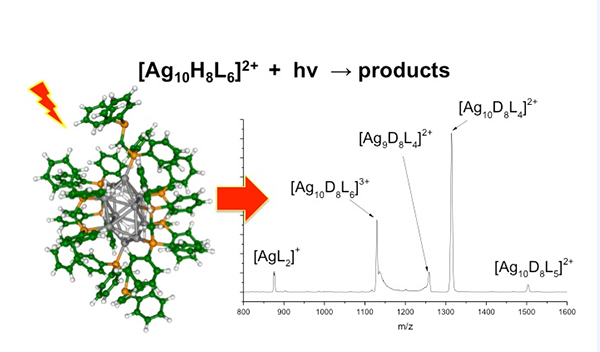Thanks to the unique properties of the synchrotron radiation, a team of international scientists successfully describe the structure of a silver hydride nanocluster. Those results, published in Physical Chemistry Chemical Physics, may pave the way for new design techniques for silver-catalyzed hydrogenation processes.
Even though they represent key intermediates in reaction involving organic substrates, in both gas and condensed phases, silver hydride nanoclusters have for a long time largely eluded their structural characterization. In this study, scientists reported for the first time the use of VUV radiation to examine the ionization and fragmentation of ligated silver deuteride nanocluster cations. They took interest to the bis(diphenylphosphino)methane (L = Ph2PCH2PPh2) ligated silver deuteride nanocluster dication, [Ag10(D)8(L)6]2+ which has been synthesized in the condensed phase. The photoionization and photo-fragmentation of this mass-selected cluster were studied using a linear ion trap coupled to the DESIRS VUV beamline of the SOLEIL synchrotron, and compared to calculations. The calculated lowest energy structure of the [Ag10D8L6]2+ nanocluster contains a symmetrical bi-capped square antiprism as a silver core in which hydrides are located as a mix of triangular faces and edges. Four of the bisphosphines bind to the edges of the cluster core as bidentate ligands, the remaining two bisphosphines bind via a single phosphorus donor atom to each of the apical silver atoms.
To come to this conclusion, scientists from France, Croatia, Australia and Germany examined and characterized the silver nanoclusters formed by ionization of the initial nanocluster, which here has been exposed to photons with an energy of 15,5 eV. Since the ionization energy of coinage metal nanoclusters is related to their structure, researchers determined the onset energy for ionization of [Ag10(D)8(L)6]2+ from a linear fit of the yield of one the product ion as a function of the VUV energy used. The experimental onset energy (9,3eV+/-0.3) then provided an opportunity to test potential structures of [Ag10(D)8(L)6]2+determined via DFT.

The VUV photoionization and photo-fragmentation of a mass-selected, ligated silver deuteride nanocluster was studied in a linear ion trap.
The coupling of a commercial linear ion trap mass spectrometer with electrospray ionization with VUV radiation from a synchrotron source provides a unique instrument to examine the photoionization and photo-fragmentation reactions of metal nanoclusters. It adds to the arsenal of techniques available to examine the fundamental properties and reactions of metal nanoclusters. In the past decade, the development of coinage metal nanoclusters with 2 – 20 metal atoms of copper, silver and gold, for applications in green chemistry, biology and physics, including hydrogen storage, has been an exciting and active research field. Fundamental information on their ionization energies is directly relevant to their role in catalysis and photo-catalysis. Therefore, these findings could have several applications for the design of new silver-catalyzed hydrogenation processes.
